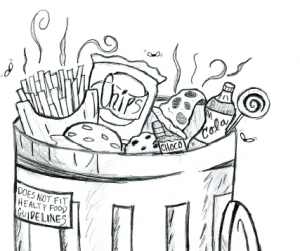 Two hundred calories is the equivalent of 33 grams of mixed nuts, 333 mL of milk, or 37 grams of potato chips. It is also now the federal standard for calories allowed in snacks served by schools. First Lady Michelle Obama’s activism for healthier food in public schools has led to the passage of the Healthy Hunger-Free Kids Act, which tightened nutritional standards considerably.
Two hundred calories is the equivalent of 33 grams of mixed nuts, 333 mL of milk, or 37 grams of potato chips. It is also now the federal standard for calories allowed in snacks served by schools. First Lady Michelle Obama’s activism for healthier food in public schools has led to the passage of the Healthy Hunger-Free Kids Act, which tightened nutritional standards considerably.
Elementary schools no longer have access to sodas of any kind and must serve only juices, low-fat milk, and water. High schools can only access diet sodas. Snacks with a higher calorie count will no longer be vending machine staples, and will be replaced by granola bars and similar items. The purpose of these new regulations is to monitor the food adolescents consume when away from home. While the intentions of school lunch reform are pure, the methods are flawed and may ultimately prove ineffective.
Many schools have upgraded to nutritious snacks and healthier foods containing whole grains and lower sodium, fat, calorie, and sugar levels. The rapid change has offered students no time to adjust to a radically different diet. As a result many students are simply throwing away their food, at a cost to both themselves and their schools. Schools are already facing mounting budget costs, and it is a colossal waste of time and financial resources to prepare meals that will go uneaten. It is unfair to have children leaving lunch hungry because they cannot eat what is provided.
Furthermore, high school students are largely able to evade regulations. Many high-schoolers have an independent source of income as well as the ability to drive. There is no way to restrict the right of students to bring their own lunch or leave school to buy their own elsewhere. That in turn leaves schools in a financial bind if they can no longer rely on the income derived from students regularly buying lunch.
A more practical solution to combat childhood obesity would be a more gradual tightening of nutritional standards over time to help children adjust. Adding healthier sides to traditional meals instead of replacing them entirely, while slowly reducing fat and calorie content over the next several years, would ease the process along. Time would make it easier for adolescents to accept the replacement of their favorite foods they have eaten in school for years and ultimately help achieve the goal of a healthier America overall.


































